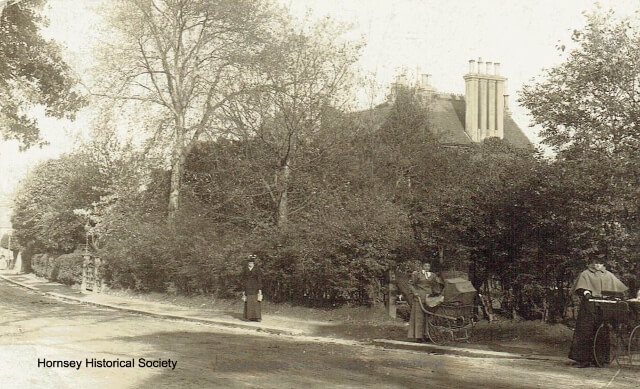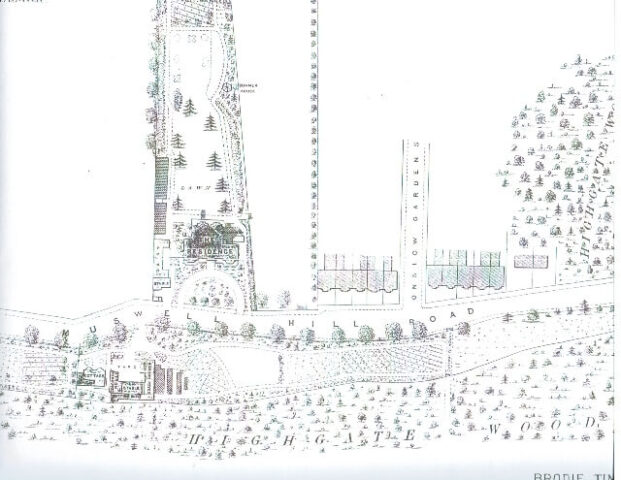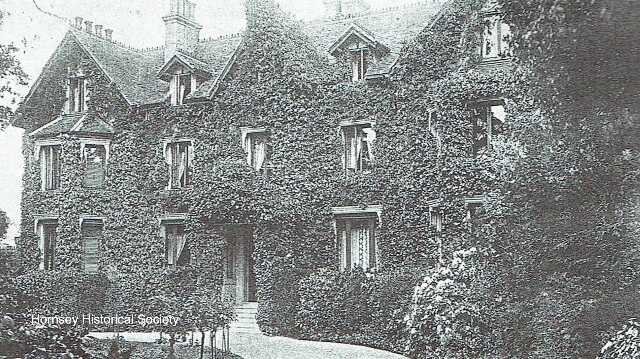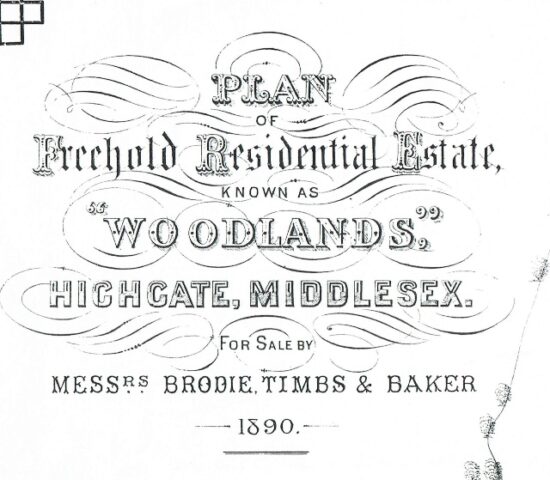This is the fifth article in the series on Lost Houses of the Hornsey area. This mid-19th century house and grounds was situated on Southwood Lane (now Muswell Hill Road N10) and is associated with the Victorian literary elite.

Woodlands was the country residence of Frederick and Nina Lehmann. They knew many Victorian literary and artistic celebrities, including Charles Dickens, Wilkie Collins, Robert Browning and Edwin Landseer. Woodlands was their Muswell Hill retreat.
Situation of the house and garden
Woodlands, built c.1850, was positioned between what are now Woodland Rise and Woodland Gardens, N10, which lead from Muswell Hill Road steeply down to Cranley Gardens and Park Road, which links Muswell Hill with Crouch End. The house was set back slightly from Muswell Hill Road with a sweeping drive up to the front door. To the left of the drive, screened by bushes, was the coach house. Behind that was a large dovecote overlooking the rear lawn.

The house had three floors and attics. By 1890 the frontage was covered in ivy; to the rear was a large conservatory and a balcony extended across most of the first floor, supported on columns. This created a verandah on the ground floor where garden furniture was set out in summer for the family and guests to sit and enjoy the large flower beds of roses with pink and purple flowers, dahlias, asters, nasturtiums and canariensis palms.

Across the road from the house, on a long thin strip of land backing onto Highgate Wood, were the gardener’s cottage, stables, kitchen gardens, beehives, pigsty, pasture and shelter for a cow, and other out-houses. In total, Woodland and its grounds covered seven acres. The sale plan of the estate, prepared in 1890 long after the Lehmanns had left Woodlands, shows the layout clearly.
The Lehmann owners 1861-c.1875
Looking for a healthy retreat, the Lehmanns viewed Woodlands in 1861and rented it from a Mr Cameron. They soon persuaded him to sell it to them and made extensive alterations over the next few years. FG Widdows, the architect they employed, later related how Frederick Lehmann showed him over the house but omitted one room where Wilkie Collins, the author, was writing a novel. The builder, Mr Colls tried to demonstrate a weighted ladder which was designed to act as a fire escape to the floor below. It refused to work which amused Frederick, who shouted, ‘Remember, the flames are roaring and raging around us…Great Heaven, this is death!’. Mr Colls was not amused.
The outlook from Woodlands
Nina Lehmann loved the peace and beauty of the grounds and retreated there from her busy life in London. She wrote to a friend, ‘If I could only give you a picture … of the brilliant beauty in which Woodlands is bathed this morning. The atmosphere is so clear that we see to the Essex Hills, over the terraces of trees, the ivy-covered tower of Hornsey, the lines of delicious green fields dotted with white houses –sheep –horses- cattle’.
Who were the Lehmanns?
Frederick Lehmann (1826-1891) was born in Hamburg into an artistic family. His father and two of his brothers were distinguished painters and Frederick was a talented amateur violinist. All his life he was constantly divided between his love of music, art and literature and his determination to achieve business success. He left Germany at an early age, coming first to England and then to Scotland. He became a partner in the engineering firm Naylor Vickers and he travelled the world on business visiting America often. He made a fortune out of the American Civil War and in 1869-70 his journeys took him to Japan and India. His eldest son, Rudolph Chambers Lehmann, later a Liberal MP, wrote, ‘My father was a man of great force of character, energy, and tireless industry’.
Whilst in Scotland Frederick married Jane Gibson Chambers (1830-1902), ‘Nina’. She was the eldest of Dr Robert Chambers’ eight daughters. He was an Edinburgh publisher and first editor of Chambers’ Encyclopedia. Nina lived in a literary atmosphere from early childhood. She played the piano as well as a professional musician. It was a very happy marriage and Nina was a devoted mother to their three sons and one daughter.
Nina enjoyed the money Frederick’s business success brought and the company of the London scene. When she was 34 years old she was forced to seek a cure for an inflammation of the lungs which could have turned into TB. She spent more time at Woodlands as a result.
For photographs of the Lehmann family see the Camille Silvy 1860 portraits on the National Portrait Gallery website.
The Lehmanns as hosts
It is not always possible to separate their activities as hosts at Woodlands from the hospitality they offered in Town, first at Westbourne Terrace, then at Bolton Street and finally, Berkeley Square. A letter from Sir George Grove, director of the Royal College of Music, described a Sunday spent with them in 1863. After lunch, the company went by carriage or on horseback to see Woodlands. ‘A very pretty neighbourhood and a very pretty new house – everything regardless of expense, but in very good taste’. They returned to Westbourne Terrace for dinner when Robert Browning and others joined them. The Lehmanns allowed friends to stay at Woodlands when they were travelling abroad.
The most interesting literary friendship was with Charles Dickens whom they knew so well that they went to pay their respects to his lifeless body when he died at Gad’s Hill Place, Rochester, in 1870. It is most likely that he visited them at Woodlands though there is no documentary evidence. Other members of their circle were George Eliot, Lord Leighton, John Everett Millais, Sir Edwin Landseer, Sir Arthur Sullivan and many more. Wilkie Collins, a particular friend, dedicated his novel Man and Wife to the Lehmanns.
The end of an era
With the coming ever closer of railway lines and the threat of urban development round the corner, the Lehmanns abandoned Woodlands in the mid-1870s. After declining health in the 1880s, Frederick died in 1891 aged 65. He left an estate valued at £543,098, many millions of pounds in today’s money.

In 1890 the estate was put up for sale and bought by builder Richard Metherell who employed architect John Farrer to design the houses in Woodland Rise and Woodland Gardens and more houses on either side of Muswell Hill Road.
Further reading
‘Woodlands, a footnote to Victorian literary history’ by Jules Kosky in People and Places, HHS, 1996
The Growth of Muswell Hill, self published, Jack Whitehead 1995
Image credits
Hornsey Historical Society